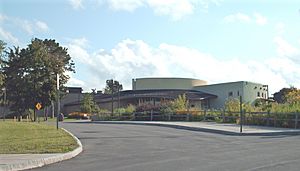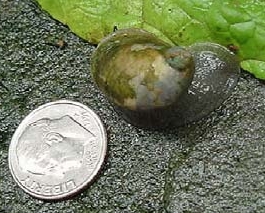Rosamond Gifford Zoo facts for kids

Rosamond Gifford Zoo logo
|
|

Main building and entrance to the zoo
|
|
| Date opened | 1914; 1986 |
|---|---|
| Location | Syracuse, New York, United States |
| Land area | 43 acres (17 ha) |
| Coordinates | 43°02′32″N 76°10′52″W / 43.04222°N 76.18111°W |
| No. of animals | 900+ |
| Memberships | AZA |
The Rosamond Gifford Zoo at Burnet Park is a zoo in Syracuse, New York. It is owned and operated by Onondaga County Parks with support from Friends of the Zoo. The zoo is home to more than 700 animals on 43 acres (17 ha). Some of the more popular animals include Asian elephants, Humboldt penguins, and Amur tigers. The zoo also houses a conservation education center, banquet/meeting space, Jungle Cafe, and gift shop.
The Rosamond Gifford Zoo has been an accredited member of the Association of Zoos and Aquariums (AZA) since 1987.
History
- Origins
The first incarnation of the zoo was a small, four acre facility in Burnet Park owned and operated by the Syracuse Department of Parks and Recreation. After opening in 1914, the zoo's first expansion began in 1916 with the construction of stone exhibits for bears and a waterfowl pond. By 1933, the zoo had doubled in size, and by in 1955 a children's zoo and monkey exhibit had been built.
- Decline
The zoo's decline began in the early 1960s as Syracuse's tax base started to shrink and financial support for the zoo began to erode. In 1974, two teens broke into the zoo and managed to kill and injure about forty animals. The city's financial position and the break-in fueled public debate over the future of the zoo.
Despite the creation of the Friends of the Burnet Park Zoo in 1970 and a grant received by the city to enlarge the zoo to 18 acres (7.3 ha), add a boardwalk, a western plains habitat, and construct a new perimeter fence, the city of Syracuse transferred control of the zoo to Onondaga County Parks in 1979.
- Renewal
A study by County Parks staff produced a forty-page renovation plan for the zoo which involved shutting down the old zoo and constructing another. The plan was approved by the Onondaga County legislature in 1981. The old zoo was closed in 1982 and the $13 million project ($10 million of which was provided by the county and the rest by the Friends of the Burnet Park Zoo) began in 1983.
The zoo reopened in 1986 and received its accreditation from the Association of Zoos and Aquariums the following year; it was re-accredited a decade later. The zoo initiated a capital campaign in 1998 to fund a new conservation and education center and tiger and rainforest exhibits. Following a $2 million endowment by the Rosamond Gifford Charitable Corporation in 1999, the zoo was renamed the Rosamond Gifford Zoo at Burnet Park.
The next several years saw the introduction of the zoo's first lion cubs in over a decade, as well as the creation of a tiger trail featuring a pair of Amur tigers, a social animals exhibit, and a penguin exhibit, which was completed in 2005 and features a colony of 32 Humboldt penguins. Since then the zoo has successfully raised numerous penguin chicks. During this period the zoo became the second in the United States to successfully raise red panda triplets. Asian elephants, Amur tigers, Humboldt penguins, snow leopards, golden lion tamarins, markhor goats and red pandas, all endangered species, are among those that have been bred successfully at Rosamond Gifford Zoo at Burnet Park.
Exhibits
- U.S.S. Antiquities Aquarium
The U.S.S. Antiquities Aquarium is an exhibit that simulates a submarine voyage through time from life's earliest days in the ocean to creatures living on land. Exhibits range in size and include insects, aquatic life, reptiles and amphibians. Fish species include clownfish, cow fish, archerfish and porcupine pufferfish . Amphibian species include poison dart frogs and Panamanian golden frogs, which are considered extinct in the wild. Reptiles species include gila monsters, Caiman lizards, yellow-spotted Amazon River turtles, and a rhinoceros iguana.
- Adaptations
The Adaptations exhibit features animals that have in some way adapted to their surroundings in nature with a main focus on nocturnal adaptions. Animals include North American river otters, an ocelot, fennec foxes, naked mole rats, seahorses, and Hoffmann's two-toed sloths.
- Diversity of Birds Aviary
The aviary is a large, one-room free flight exhibit that primarily features warm weather birds such as the scarlet ibis, roseate spoonbill, and Nicobar pigeon.
- Social Animals and Rainforest
This exhibit is home to animals that live together in groups and includes golden lion tamarins, patas monkeys, lemurs, siamangs, meerkats and Colobus monkeys. The zoo has had recent success with breeding patas monkeys and currently has the nation's second largest troop.
- Outdoor Birds
This exhibit showcases aquatic birds including the Chilean flamingo, the North American wood duck, and the American common goldeneye. Other smaller exhibits feature laughing kookaburras, turkey vultures, a barn owl, a Eurasian eagle-owl and several other species of raptor.
- Wildlife Trail
Wildlife Trail is a 0.5-mile (0.8 km) trail that takes visitors past animals such as blue cranes, markhor, Amur tigers, red wolf, Thorold's white-lipped deer, Asian elephants, red pandas, Humboldt penguins, Andean bears, Andean condors, gray wolves,snow leopard and Amur leopard.
- Asian Elephant Preserve
In December 2007, the Onondaga County Legislature approved a $6 million expansion of the Asian elephant exhibit to enable the elephant breeding program to grow in the future. Asian Elephant Preserve was completed in August 2011. The exhibit is home to the zoo's famous Asian elephant herd. The new exhibit features a spacious yard and a new holding facility with room for up to 12 elephants.
The zoo breeds and houses Asian elephants as part of the Species Survival Plan for this critically endangered species overseen by its accrediting organization, the Association of Zoos & Aquariums.
In a recent Harris Interactive Poll, 95 percent of respondents agreed that seeing elephants in zoos helps people appreciate them more. That same poll found that 86 percent of respondents believe that visiting zoos and aquariums encourages people to donate time and/or money to conservation. While television, books, movies and videos can provide factual information, they cannot match the emotional impact of seeing live animals.
- Domestic Animal Barn
The Domestic Animal Barn exhibit features Guinea hogs, miniature donkey, alpacas, sheep, and goats.
- Primate Park
Primate Park, which opened in 2010, is an outdoor exhibit with mesh walls, swinging vines, large rocks, and a waterfall which exhibits siamangs and patas monkeys on a rotating basis. This new exhibit replaces the old "Monkey Island" in the same location that featured a small climbing structure surrounded by a small moat which was used to exhibit white-handed gibbons.
New exhibits
The zoo has been updating and renovating old exhibits and building new ones. In 2013, the zoo opened a new giant Pacific octopus exhibit outside of the U.S.S. Antiquities area, a first for the zoo.
Conservation programs
As an accredited member of the AZA, wildlife conservation is one of the primary goals of Rosamond Gifford Zoo. The zoo participates in a number of programs to further conservation and animal welfare.
On-site programs
Species Survival Plan (SSP) helps maintain the diversity of animals with limited population. Zoos all over the world participate in the program by lending their animals to other zoos to mate and produce genetically diverse offspring. This plan is managed using a breeding registry called a studbook. The Rosamond Gifford Zoo participates is SSP for threatened and endangered species including Amur tiger, Andean condor, Asian elephant, black and white ruffed lemur, golden lion tamarin, Humboldt penguin, ocelot, red panda, red wolf, ring-tailed lemur, siamang, snow leopard, Andean bear, Turkmenian markhor and white-lipped deer, among others.
Research program
The Rosamond Gifford Zoo has teamed up with U.S. Fish and Wildlife Service, the New York State Department of Environmental Conservation, Seneca Park Zoo in Rochester, the New York State Office of Parks, Recreation and Historic Preservation, and SUNY College to help protect a snail, called Chittenango Ovate Amber Snail (COAS). It was found by a resident in upstate New York and only exists in Chittenango Falls State Park. Research population surveys of COAS show only about 300 exist in the world. The New York state has listed COAS as an endangered species. The zoo has established a COAS colony with a temperature controlled terrarium that houses approximately 400 captive COAS.
Other conservation programs
Population Management Program (PMP) helps AZA-accredited zoos manage and conserve a select wild species population with voluntary cooperation of AZA-accredited zoos, aquariums, and other approved participants.
Taxon Advisory Groups (TAG) are composed of expert advisors who help to identify, manage and support AZA's cooperative animal management programs. They also serve as experts regarding the husbandry, veterinary care, conservation needs/challenges, research priorities, ethical considerations, and other issues pertaining to their taxa.
Conservation Action Partnership (CAP) is a membership of organizations that support the vision and mission of zoological parks, aquariums, wildlife parks, and oceanariums. As a Conservation Partner member of the AZA, Rosamond Gifford Zoo embraces the work of AZA-accredited aquariums, zoos, staff, and volunteers working to save wildlife.
Education programs
Rosamond Gifford Zoo offers many educational programs for a wide variety of visitors.
Zoo to You
This is a traveling, inquiry-based educational program that visits schools, libraries, community centers, senior centers/facilities, day care centers, scout groups and more which is represented by professional zoo educators. The purpose of this program is to increase awareness of the animal kingdom and encourage participants to be conscious about the environment. Zoo to You includes live animals that may be touchable such as birds, reptiles, and invertebrates.
Summer Zoo Camp
Summer Zoo Camp is an 8-week camp session for specific age groups. It consists of zoo tours, hands-on activities, games, and crafts and interact with animals and staff at the zoo.
Seasonal camps
School Break Zoo Camps are for kids off from school where they will get a chance to tour the zoo, see animals up close, play games, and make crafts for one day or all week.
EdVenture Academy
This program provides an opportunity for children and their parents to learn more about the animals at the zoo. This is designed for a specific age group and includes craft, snack, biofact (skulls, fur, feathers, etc.) presentation, zoo tour and may include an animal encounter or keeper talk.
Adult Program - Twilight at the Zoo
This program is specifically for adults ages 21 and over where they get the chance to learn about the zoo and the animals. The program features the zoo's endangered Asian elephants including a behind-the-scenes tour of their Asian Elephant Preserve.
On-Site Educational Programs - Zoo Safari
Zoo Safari involves students in hands-on learning during a field trip to the zoo's 43-acre living classroom. It includes an hour-long multi-media program which features live animal encounters and animal artifacts. This program also offers a Flashlight Safari where students or a group experience an adventure at the zoo after hours. This is an evening tour of the animal diet kitchen and social area, an outreach animal visit that features touchable animals and an after-dark tour of the Wildlife Trails.
Adopt an Animal
All of the animals at Rosamond Gifford Zoo are available for adoption. The funds raised through the adoption program support a variety of projects which include habitat improvement, animals enrichment, research and training. All adopted animals remain in the care and custody of the zoo.


